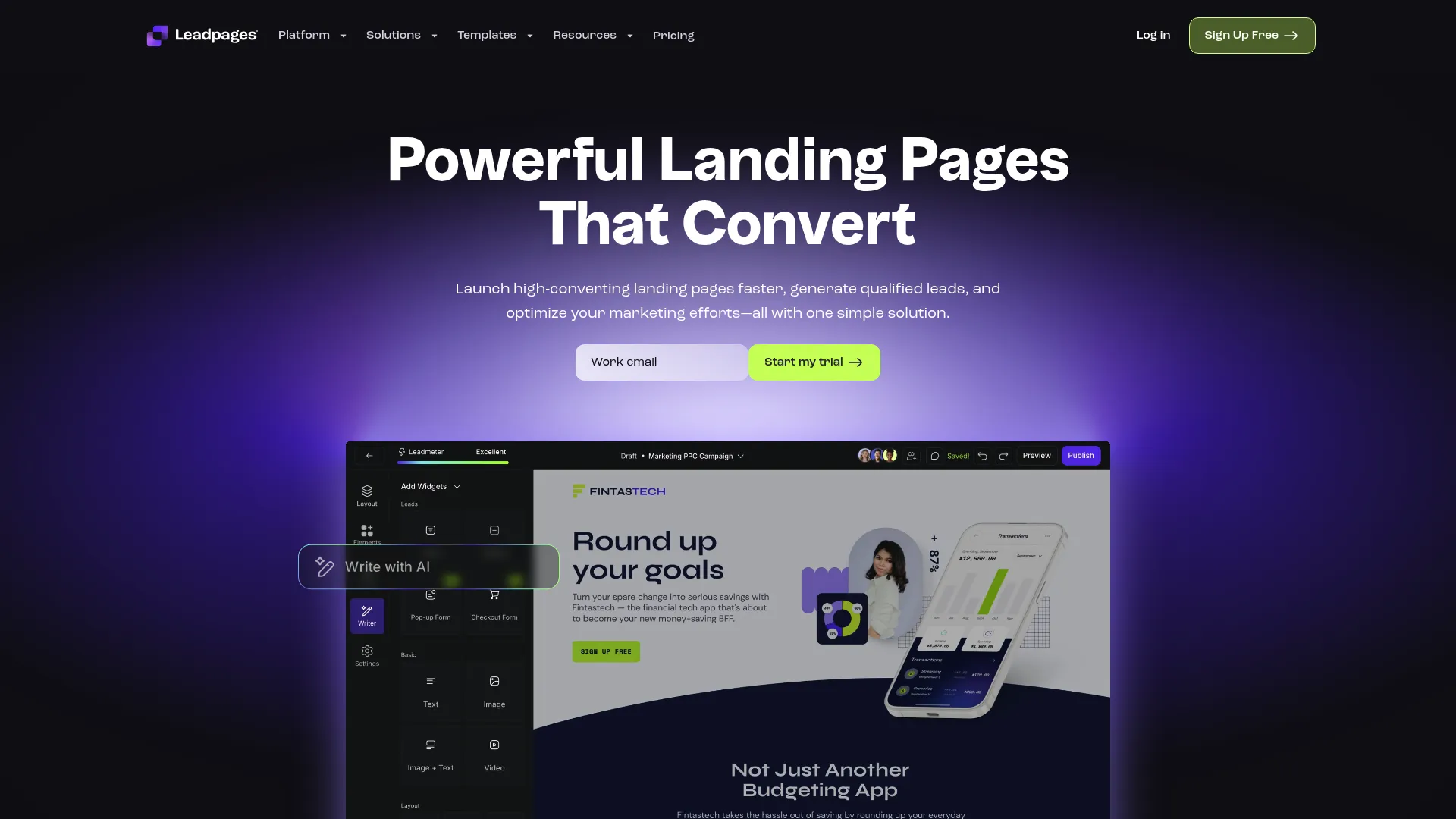
Leadpages Review: My Honest Take After Testing Every Feature
So I’ve been playing around with Leadpages for the past month, testing pretty much every feature they’ve got. Bottom line? It’s actually pretty decent if you’re just starting out and don’t want to break the bank. But if you’re looking for something super customizable, you might want to keep looking. This review breaks down exactly where Leadpages shines and where it… well, doesn’t.
Table of Contents
- TL;DR: Key Takeaways
- Criteria Table
- Leadpages
- Alternatives to Leadpages
- Frequently Asked Questions
- Final Thoughts
TL;DR: Key Takeaways
- Leadpages has 150+ templates that are built to convert, and at $37/month, it won’t break the bank for small businesses
- The platform is super easy to use and plays nice with other tools, but man, the customization options are pretty limited
- A/B testing on the basic plan is basically useless – which is frustrating for a platform that’s supposed to be all about conversions
- Your pages will look fine on mobile, but you can’t tweak the mobile and desktop versions separately
- It’s cheaper than the fancy competitors like Unbounce and Instapage, but you definitely get fewer bells and whistles
- Customer support is actually pretty solid and they’ve got tons of helpful resources for beginners
- Fair warning: the drag-and-drop builder can be painfully slow sometimes
Criteria Table
| Criteria | Score | Notes |
|---|---|---|
| Template Quality & Variety | 3.5/5 | 150+ templates that work, but some look stuck in 2018 |
| Ease of Use | 4/5 | Super beginner-friendly, but the builder can be sluggish |
| Customization Flexibility | 2.5/5 | Pretty limited – you’re mostly stuck with what you get |
| A/B Testing Capabilities | 3/5 | It exists, but the basic plan restrictions are annoying |
| Mobile Responsiveness | 4/5 | Works automatically, just can’t edit mobile separately |
| Integration Options | 4/5 | Connects with pretty much everything you’d want |
| Performance & Speed | 3/5 | Published pages are fast, but building them… not so much |
| Pricing Value | 3/5 | Good price, but those feature limits sting |
| Support & Resources | 4/5 | Actually helpful support and tons of learning materials |
| Analytics & Reporting | 4/5 | Covers the basics and then some |
Leadpages
What Leadpages is Best Known For
Leadpages has built its reputation as the landing page builder for people who just want things to work without jumping through hoops. They’re not trying to impress you with flashy features – they just want to help you create pages that actually convert visitors into customers, and they want to make it as painless as possible.

Here’s the thing about Leadpages – they know their lane and they stick to it. While other builders are out there trying to be the Swiss Army knife of landing pages, Leadpages is more like a really good hammer. Simple, reliable, and gets the job done.
Their whole approach is about removing the barriers that usually stop small business owners from creating decent landing pages. No coding knowledge required, no design degree needed, and honestly, no massive time investment to figure out how everything works.
What I appreciate about them is they’re not pretending to be something they’re not. They’re not going to revolutionize your entire marketing strategy or blow your mind with cutting-edge AI features. But if you need a landing page up and running by tomorrow? Yeah, they’ve got you covered.
Features
Leadpages centers everything around their drag-and-drop editor and a library of 150+ templates. You’ve also got conversion optimization tools, pop-ups, checkout functionality (on the pricier plans), AI writing help, and solid WordPress integration. Let me walk you through what actually matters.
The drag-and-drop editor is the heart of everything. You can build from scratch or customize their templates without touching any code. It’s genuinely easy to use, though I’ve gotta warn you – it can get pretty sluggish when you’re making lots of changes. I literally went to grab coffee while waiting for a simple text edit to load.
Their template collection is actually pretty solid. With 150+ options covering different industries, you’ll probably find something that works for your business. And here’s what I love – each template shows you its actual conversion data. No guessing about what works.
The Leadmeter tool is surprisingly helpful. It’s like having that brutally honest friend who’ll tell you straight up: “Your headline sucks” or “Where’s your call-to-action button?” Annoying? Maybe. But it catches stuff you miss.
Pop-ups and alert bars come included, which is nice because a lot of platforms charge extra for these. They help you capture leads beyond just your main page, giving you more chances to connect with visitors.
If you spring for the Pro plan, the checkout functionality is actually pretty sweet. You can process payments right on your landing page instead of sending people somewhere else – and trust me, that can make a huge difference in your conversion rates.
The AI writing assistant helps when you’re staring at a blank page wondering what to write. It’s not going to write your Great American Novel, but it’ll give you some decent headline ideas when you’re stuck.
WordPress integration through their plugin just works. You can publish pages directly to your WordPress site without any technical headaches, which is honestly refreshing.
The Good Stuff
Won’t Break the Bank
At $37/month for the Standard plan, Leadpages costs about half what you’d pay for Unbounce ($79/month) or Instapage ($99/month). For small businesses watching every penny, that’s a pretty big deal.
No Traffic Police
Unlike some competitors who’ll throttle your pages or hit you with overage charges when you get popular, Leadpages doesn’t care how much traffic you get. Your pages can handle a viral moment without any nasty surprises on your bill.
Actually Beginner-Friendly
I watched my friend Sarah – who still calls me to help her attach files to emails – create a decent-looking landing page in under an hour. The interface just makes sense, even if you’re not tech-savvy.
Plays Well with Others
Nearly 100 integrations through Zapier, plus direct connections to all the email marketing platforms and CRMs you’d actually want to use. Setting these up doesn’t require a computer science degree.
Templates That Actually Convert
These aren’t just pretty templates – they’re built based on real conversion data. Each template shows you its conversion rate, so you can pick something that actually works instead of just looks nice.
Tons of Learning Resources
You’re not just buying software here – you get access to a whole library of marketing education. The blog, podcast, and guides actually provide value beyond just “how to use our buttons.”
Where It Falls Short
Customization is Pretty Limited
This is honestly Leadpages’ biggest weakness. Sure, the templates look professional, but try to change them significantly and you’ll hit walls fast. You’re pretty much stuck with the basic structure, which gets frustrating if you have specific ideas.
The Builder Can Be Painfully Slow
Okay, can we talk about how frustrating this gets? Sometimes I’d click to edit text and literally nothing would happen for 10 seconds. It’s not always this bad, but when it is… oof. Makes what should be a quick task feel like pulling teeth.
A/B Testing on Basic Plan is Basically Useless
For a platform that’s supposed to be all about conversions, the A/B testing restrictions on the Standard plan are just silly. It feels like they’re forcing you to upgrade for something that should be basic functionality.
Mobile Editing? Nope
Your pages will look fine on phones, but you can’t edit the mobile and desktop versions separately. So if you want different content or layouts for different devices, you’re out of luck.
Templates Look… Dated
Don’t get me wrong – they work. But compared to what you’ll see on Unbounce or Instapage, some of these templates feel like they’re stuck in 2018. They’re functional, but they won’t win any design awards.
Forms Are Pretty Basic
If you need anything beyond simple contact forms, you’ll hit limitations quickly. No conditional logic, no fancy field types – just the basics.
How It Stacks Up
Template Quality & Variety: 3.5/5
Look, they’ve got over 150 templates, which sounds impressive until you start browsing through them. They work and they’re built to convert, but some of them look like they need a refresh. I found myself thinking “this would look great… five years ago.”
Ease of Use: 4/5
This is where Leadpages really shines. The interface makes sense, the workflow is logical, and you won’t need a manual to figure things out. The only thing holding it back is that sluggish performance that makes simple edits feel like a chore.
Customization Flexibility: 2.5/5
Here’s where things get frustrating. You can make basic changes to templates, but anything beyond that becomes difficult or impossible. It’s like being given a really nice car but not being allowed to adjust the seat.
A/B Testing Capabilities: 3/5
It exists, but those restrictions on the basic plan are just annoying. For a conversion-focused platform, limiting A/B testing feels counterproductive. It’s like selling a sports car with a speed limiter.
Mobile Responsiveness: 4/5
Everything automatically adapts to mobile, which is great. The downside is you can’t customize mobile and desktop versions separately, which can be limiting when you want device-specific optimizations.
Integration Options: 4/5
Solid connections to all the tools you’d actually want to use, and the setup process doesn’t require a PhD in computer science. It just works, which is refreshing.
Performance & Speed: 3/5
Your published pages load fast and handle traffic well. But the builder itself can be frustratingly slow, especially when you’re trying to make multiple changes. It’s like having a fast car with a really slow garage door.
Pricing Value: 3/5
The price is competitive, but those feature limitations on the basic plan hurt the value proposition. The A/B testing restrictions especially make you question whether you’re really getting a good deal.
Support & Resources: 4/5
The support team actually knows what they’re talking about, and the educational resources go way beyond basic troubleshooting. You’re getting genuine marketing help, not just software support.
Analytics & Reporting: 4/5
Covers all the essential metrics you’d want to track, plus integrates nicely with Google Analytics and Facebook Pixel. Real-time monitoring helps you spot issues or opportunities quickly.
What Real Users Are Saying
Leadpages gets solid ratings from actual users – 4.6/5 stars on Capterra from 294 reviews. People consistently love how easy it is to use and how well it integrates with other tools, but they keep asking for more design flexibility and better customization options. Billing hiccups and that mobile editing limitation also come up a lot.
The Capterra reviews tell a pretty consistent story. Sarah M., a small business owner, said: “Finally found a landing page builder that doesn’t require a computer science degree. Created my first page in under an hour and it actually converts well.” That’s the kind of feedback you see over and over.
But then you’ve got Marcus T., a digital marketing consultant, who expressed what a lot of power users feel: “Great for basic pages, but I constantly hit walls when trying to customize templates. The drag-and-drop builder feels sluggish compared to other tools I’ve used.” Yep, that sluggish performance is a real thing.
Jennifer L., who runs an e-commerce business, appreciated the practical stuff: “The integration with my email platform was seamless, and I love that there are no traffic limits. My pages handled a viral social media moment without any issues.” That reliability factor comes up a lot in positive reviews.
Most experts position Leadpages as the perfect starting point – great for beginners and small businesses, but something you might outgrow as your needs get more sophisticated.
What You’ll Actually Pay
Leadpages has three main pricing tiers, and honestly, the structure makes sense. The Standard plan at $37/month (if you pay annually) gives you the core stuff – unlimited landing pages, pop-ups, and basic integrations. But those A/B testing limitations make it less appealing if you’re serious about optimization.
The Pro plan at $74/month (annual billing) is where things get interesting. You get unlimited A/B testing, can use it on up to 3 sites, get checkout functionality, and access to that AI writing assistant. For most businesses that are serious about this stuff, it’s probably the sweet spot.
The Advanced plan is custom pricing for bigger organizations. You’ll need to talk to their sales team to get actual numbers.
Compared to the competition, Leadpages is definitely more affordable. Unbounce starts at $79/month and Instapage at $99/month. But remember, you’re getting fewer features for that lower price.
Where to Get It
You can sign up directly at their website and they offer a 14-day free trial. Just heads up – you’ll need to enter payment info upfront, though they won’t charge you until the trial ends.
It’s web-based only – no desktop app or anything like that. Everything happens in your browser once you’re logged in.
Alternatives to Leadpages
Unbounce
If Leadpages is like a reliable Honda Civic, Unbounce is more like a BMW. Yeah, it costs more ($79/month vs $37), but man, the difference in performance is noticeable. The builder actually responds when you click things – imagine that!
Unbounce really shines with advanced features like dynamic text replacement, which personalizes pages based on where visitors came from. It’s the kind of thing that can seriously boost your conversion rates if you know how to use it.
You’ll pay more, but you get a lot more functionality for businesses that are serious about optimization. Check them out at unbounce.com.
Instapage
Instapage is like the luxury option – starting at $99/month, but with enterprise-grade features that justify the price tag. Their customization options are honestly impressive, making it perfect for agencies and bigger businesses.
What really sets them apart is the built-in heatmapping and advanced analytics. You can actually see how visitors interact with your pages, which is incredibly valuable for making data-driven improvements.
It’s the most expensive option, but if you need premium features and have the budget, it’s worth checking out at instapage.com.
SeedProd
SeedProd is specifically built for WordPress users, and their integration goes way deeper than what Leadpages offers. If you live in the WordPress world, this might be a better fit since it can basically rebuild your entire site, not just landing pages.
They’ve got better WooCommerce integration and you can actually edit mobile versions separately – addressing two of Leadpages’ biggest weaknesses. Plus, the performance is noticeably faster.
At $39.50/year, it’s incredibly affordable if WordPress is your thing. Just keep in mind it’s really only useful if you’re staying in the WordPress ecosystem. Learn more at seedprod.com.
ClickFunnels
ClickFunnels takes a completely different approach – instead of just landing pages, they focus on complete sales funnels. If you need to guide people through multi-step processes, this might be your answer.
It includes payment processing, email automation, membership sites – basically everything you need for complex sales processes. It’s like getting an entire marketing department in software form.
At $97/month for the basic plan, it’s pricier than Leadpages but gives you way more functionality if you need complete sales systems. Check it out at clickfunnels.com.
Frequently Asked Questions
Is it worth it for small businesses?
Honestly? If you’re bootstrapping and need something that works without a steep learning curve, absolutely. My buddy runs a local bakery and got his first landing page up in an afternoon. Could it look better? Sure. Did it help him collect email addresses for his weekly specials? You bet.
Can I use it with WordPress?
Yep, the WordPress integration is actually pretty seamless. Their plugin lets you publish pages directly to your WordPress site without any technical headaches. It just works, which is honestly refreshing.
Are the templates any good?
The templates are decent – they’ve got 150+ options that are built to convert. But I’ll be real with you: some of them look like they need a design refresh. They work, but don’t expect to wow anyone with cutting-edge visuals.
What are the biggest downsides?
The customization limits will drive you crazy if you’re picky about design, the builder can be frustratingly slow, and those A/B testing restrictions on the basic plan are just silly for a conversion-focused platform.
How does it compare to the competition?
Leadpages is the budget-friendly option that sacrifices some advanced features for affordability and simplicity. If you want more bells and whistles, you’ll need to pay more for Unbounce or Instapage.
Final Thoughts
Here’s my honest take after living with this thing for weeks: Leadpages knows exactly what it is, and it doesn’t try to be anything else. It’s the reliable friend who shows up when you need them, even if they’re not the most exciting person at the party.
If you’re a small business owner or beginner who values getting stuff done over having every possible feature, Leadpages delivers exactly what you need. You won’t spend weeks learning how to use it or pulling your hair out over technical stuff.
The platform’s biggest strength is just how accessible it is. Last Tuesday, I was helping my friend Sarah set up her first landing page. She’s not tech-savvy at all, but within 20 minutes she had something that looked pretty decent and was already collecting email addresses.
But here’s the thing – those limitations become real problems as you grow. The customization restrictions will frustrate anyone with specific design ideas, and that sluggish builder performance gets old fast when you’re trying to get work done. The A/B testing limits on the basic plan feel especially stingy for a platform that’s supposed to be about conversions.
Leadpages works best when you need function over form and want straightforward landing page creation without jumping through hoops. The educational resources and integrations add real value beyond just the software itself.
If you’re running an agency, working with demanding clients, or need sophisticated customization, you’ll probably outgrow Leadpages pretty quickly. The template-based approach and performance issues become real barriers when you’re handling complex projects.
The pricing is still competitive, especially when you factor in unlimited traffic and solid support. Just make sure those feature limitations actually align with what you need before you commit.
So would I tell my friends to use it? Yeah, but I’d also tell them what they’re signing up for. It’s like recommending a restaurant – great food, slow service. Just know what you’re walking into.
Look, is it perfect? Nope. But for 37 bucks a month, it gets the job done. And sometimes, that’s exactly what you need.





